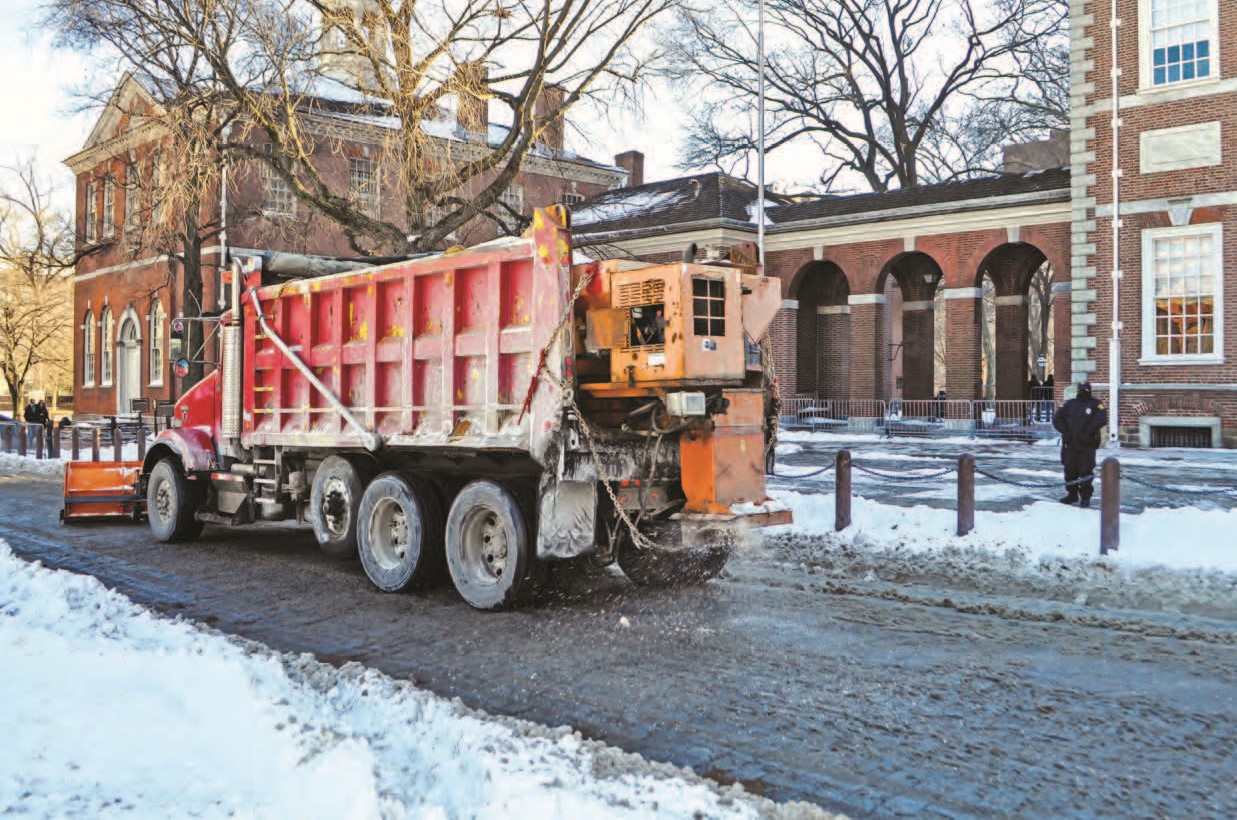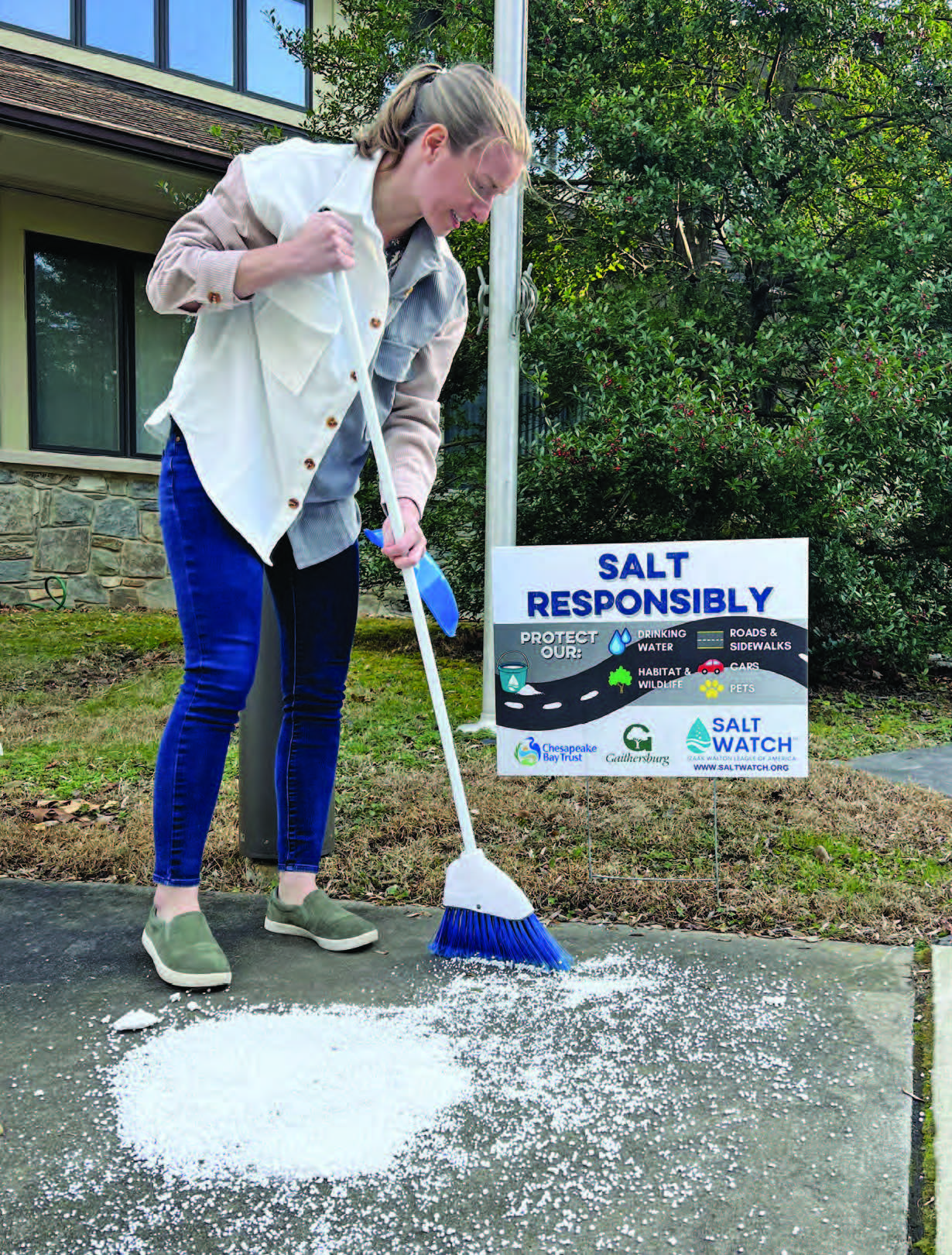The mysteries of road salt pollution shouldn’t be surprising. Salt, especially sodium chloride (NaCl), is cheap and prevents slips and falls on sidewalks and collisions on roadways during the winter.
Salt works by reducing the freezing temperature of water, which helps to keep our roadways and sidewalks free of ice in the winter. Keeping people and drivers safe during the winter is important. At the same time, we’ve all probably heard the saying “too much of a good thing.” That definitely applies to use of road salt in America.
Excessive use of salt does more harm than good, damaging and corroding our infrastructure, polluting streams and lakes, hurting or killing wildlife, sickening pets and can even release lead and other dangerous metals into our drinking water.
A health threat
Elevated levels of chloride in drinking water threaten human health. The most serious threat is heavy metal contamination. We know salt corrodes the metal on our cars and infrastructure. It can also have the same corrosive effect on the estimated 10 million lead service lines that deliver drinking water to American homes, schools and businesses.
That corrosive effect was one of the factors behind lead (Pb) ending up in residents’ drinking water during the prolonged, dangerous water crisis that began in Flint, Michigan in 2014. Now over 10 years after the Flint water crisis began, there is still lead in the tap water of many residents, although the concentration has decreased to 1 part per billion (ppb) this year (2024) as a result of lead line replacements and corrosion control measures that have been enacted. Boiling water doesn’t remove lead.
EPA, scientists and medical professionals all agree: there is no safe level of lead consumption for children, or people of any age. Also, people on restricted salt diets may not realize that they are getting additional salt from their drinking water.
Road salt cannot be removed by most water treatment facilities, and most home filtration systems cannot remove it either. Water would need to go through a reverse osmosis or desalination process for the salt to be removed from tap water.
 Applying too much road salt harms infrastructure, vehicles, aquatic life and drinking water.
Applying too much road salt harms infrastructure, vehicles, aquatic life and drinking water.Little goes a long way, costs appear down the road
Once salt enters the environment, there is no feasible way to remove it. Chloride in road salt and other de-icers persists as a long-term pollutant. When spread on roads or sidewalks where rain eventually washes it into the ground, it can stay in soils and groundwater for years. Even if we stopped using road salt today, many areas would be polluted for years to come.
To understand the impact, start with the fact that one teaspoon of salt can permanently pollute five gallons of water. Because road salt is normally sold in a 50-pound bag, that bag has the potential to pollute 10,000 gallons of water (about the amount in a residential swimming pool). Depending on the severity of our winter weather, we apply between 10 to 20 million tons of road salt annually in the U.S. And that number doesn’t even factor in the millions of pounds of salt also entering waterways through other means—like water softener discharge, industrial and processing wastes, saltwater swimming pools and more.
The real cost of road salt
Salt is cheap, costing about $75 per ton. But the real cost that consumers, businesses and government bear is far higher. Bolton and Menk, Inc. (formerly Fortin Consulting) has estimated that the long term cost of each ton of road salt applied can be as high as $17,000 when we consider the impacts on roads, bridges, vehicles, vegetation, water supplies, human health and utilities.
A range between $1,740-17,086 per ton in damages, adjusted for inflation, originated from the following studies: Vitaliano 1991, low estimate and Murray and Ernst, 1996 and Murray and Brenner, 1977, high estimate.
Between a rock salt and a hard place
So why haven’t we stopped using salt or found an alternative? The answer is as multi-faceted as the impacts salt has when released into the environment. Here are a few of the reasons:
- Salt helps to improve safety on roads and sidewalks
- Alternatives are costly and anything applied has some sort of impact
- Salt is cheap to buy (but the damages from road salt are expensive)
- Expectations have changed around how often we can travel in the winter
- People don’t know that salt is a pollutant
- The labeling on salt bags is unregulated and is misleading
- “Ecofriendly” and “pet-safe” salt is usually neither!
Often, for-hire or contracted road salt applicators (such as landscape companies) overapply road salt because they don’t have the training, background or updated (and in many cases expensive) equipment owned by state or local departments of transportation. Also, the financial incentive is inverted: these applicators are frequently paid according to the number of pounds or bags of road salt applied during a storm event instead of by performance-based practices (which require applicators to assess conditions and apply chemicals based on actual conditions rather than a contracted minimum number of bags or tons).
Departments of transportation can help to reduce the amount of salt used. They train plow drivers on salt application, calibrate equipment to minimize excessive use and have a powerful financial incentive not to waste taxpayer dollars by using more salt than is really needed.
The people who apply road salt don’t have an easy job, which is to keep people safe in the winter. In most cases, applicators are pressured by public perception to use more road salt. Many people believe that more salt equals more melting and that you should see and feel salt underfoot during the winter. Both assumptions are incorrect. A little bit of salt goes a long way (both in melting ice and in polluting the environment).
A local road salt applicator recently told Salt Watch staff that his company intentionally oversalts in the winter. The reason for this is unfortunately simple—they don’t want to be sued. A lawsuit would cost the company a lot of money if they were sued due to a slip and fall, much more money than spending more on salt because of oversalting practices. And many road salt applicators feel the same way.
Training and awareness: worth its salt!
 The author demonstrates how to sweep up excess salt for reuse so it doesn't wash into local waterways.
The author demonstrates how to sweep up excess salt for reuse so it doesn't wash into local waterways.
What would happen if the threat of lawsuits became less likely? Applicators wouldn’t have to base their applications on public perception, but instead would be able to lean on best practices.
Fortunately, more and more states across the country are offering training for private road salt applicators—not just for applicators in the public sector like departments of transportation.
Starting in Gaithersburg, Maryland, the Izaak Walton League has provided leadership in the effort to train applicators in smart salting.
These trainings cover a range of topics, including environmental impacts of road salt, cost savings when changing business practice to performance-based application and using road temperature and weather conditions (current and predicted) to determine road salt applications.
But public perception can still interfere. One of the current road salt best practices is to use brine (a salt/water mixture) that is sprayed on roadways and sidewalks in a wet-dry pattern. Sometimes when customers don’t see or feel the salt, they still complain to property managers and business owners because they cannot see salt application in place. So, how can this be fixed? Education.
Educating road salt applicators, educating business owners and managers, and educating the public. And especially making sure that there are incentives in place to increase knowledge around road salt application.
State progress
In 2013, New Hampshire passed legislation to create a training program called the “Commercial Green SnowPro Certification.” The program is run by the New Hampshire Department of Environmental Services.
Commercial road salt applicators who take and pass the training, maintain best practices learned in the training and keep records of their practices (including de-icing materials used, rate or quantity of de-icing materials used, dates of treatment and the weather conditions for each event requiring de-icing) are granted limited liability protection against damages arising from snow and ice conditions.
Property managers and owners who hire those certified applicators are also granted the same protection. This voluntary certification approach allows road salt applicators who are trained in best practices to use the knowledge they have learned to shift the scale back to center when balancing between safety and environmental protection without needing to worry about liability due to slips and falls. (Read more about the program.)
During the past few years, legislators in Minnesota and Wisconsin have unsuccessfully put forward bills to create programs similar to New Hampshire’s Green SnowPro Certification. We expect that similar bills will be introduced again this upcoming legislative session in both states. Bills like this need our support.
Everything is a balance. It is time to tip the scales so that both safety and environmental protection are at the forefront when applying road salt in the winter.
Staying safe, not salty
The public needs more knowledge about the dangers of road salt pollution and how each of us can help to reduce our impact. Knowledge building and education need to happen at every level and we all have our parts to play in reducing the amount of road salt in the environment.
Simple actions like shoveling early and often to remove snow before it turns to ice, scattering or sprinkling salt instead of piling it on, and sweeping up spilled salt or salt remaining after a storm event are easy actions each of us can take to reduce the amount of road salt entering the environment.
Testing water using Salt Watch kits is also a way to learn more about what is happening in waterways we care about, including our tap water. Since winter is coming, this is the time to think about smart salting and what we can do to reduce the amount of road salt entering the environment.
Learn more about Salt Watch
Advocacy Tips
As awareness around road salt pollution spreads, we expect that more and more states will strive to follow New Hampshire’s example by incentivizing smart salting practices. You can also write to your state legislators to encourage them to support and even write bills focused on reducing road salt pollution and creating training programs and incentives for road salt applicators.
To keep up to date with bills related to road salt pollution reduction in your state, sign up for action alerts.
Top photo: Through policy advocacy, volunteer science and community-based conservation, the Izaak Walton League works to stop pollution at the source and keep it out of America's waterways. Credit: Pexels.